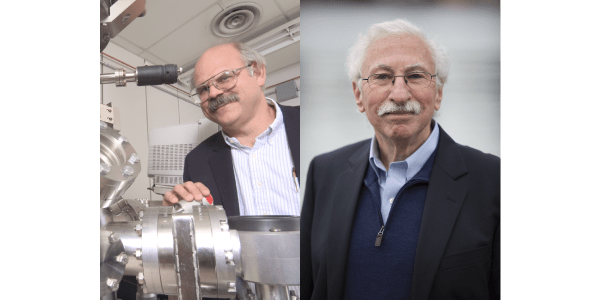The journal Biointerphases recently recognized David Castner, UW professor of bioengineering and chemical engineering, for his contributions to the journal over its lifetime. Dr. Castner has authored or co-authored a number of highly-cited publications for the journal which demonstrate excellence in quantitative characterization at the biointerface. Dr. Castner is also acknowledged for his work to support the journal, including reviewing, and editing two special issues of the journal.
One of the special issues edited by Dr. Castner celebrates the 70th birthday of Buddy Ratner, professor of bioengineering and chemical engineering, and the Michael L. & Myrna Darland Endowed Chair in Technology Commercialization at UW. The special issue, part of Biointerphase’s June issue, features articles focusing on protein structures at biointerphases, and an editorial written by Allan Hoffman, professor emeritus of bioengineering, that documents the evolution of Dr. Ratner’s career to become a pioneer in the field of biomaterials.
Dr. Ratner began work a postdoc in Dr. Hoffman’s lab at UW in 1972 following his completion of a Ph.D. at Brooklyn Polytechnic Institute, where he investigated the design and synthesis of hydrogels as new dialysis membranes. With Dr. Hoffman and current Professor Emeritus Thomas Horbett, and later Dr. Castner, who was a postdoc of Dr. Ratner’s, Dr. Ratner formed UW’s biomaterials research group. The team became leaders in the study of compatibility between the body and synthetic materials.
The team’s novel research discoveries led to the founding of the National Institutes of Health (NIH)-funded National ESCA and Surface Analysis Center for Biomedical Problems (NESAC/BIO) in 1984. Dr. Ratner led the center for 14 years. Currently, Dr. Castner serves as the center’s director, which has become world-renowned for developing techniques to study interactions between proteins and cells with solid surfaces.
In 1995, the UW received a $40 million investment from the National Science Foundation (NSF) to establish an Engineering Research Center (ERC) to investigate new directions in the field of biomaterials. The Engineered Biomaterials (UWEB) program sought to develop new materials that integrate with the body to promote healing, and that facilitate drug delivery. This work would lead to innovation in biomedical devices like implants, and new ways to facilitate drug delivery. Dr. Ratner led UWEB under NSF support for 12 years, and continues to lead UWEB today as an independent program.
In addition to his continued biomaterials research, Dr. Ratner currently co-leads the new Center for Dialysis Innovation with Dr. Johnathan Himmelfarb, a UW School of Medicine professor and director of the Kidney Research Institute. The CDI aims to improve the health and well-being of people with advanced kidney disease by applying biomaterial and bioengineering technologies to transform dialysis care. Its vision is that future dialysis therapy will be complication-free and completely restore kidney health.



